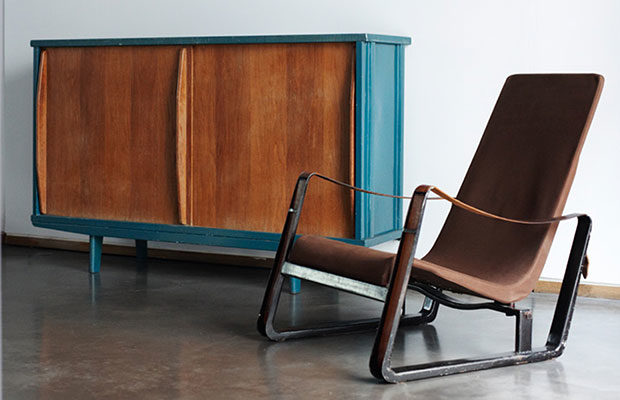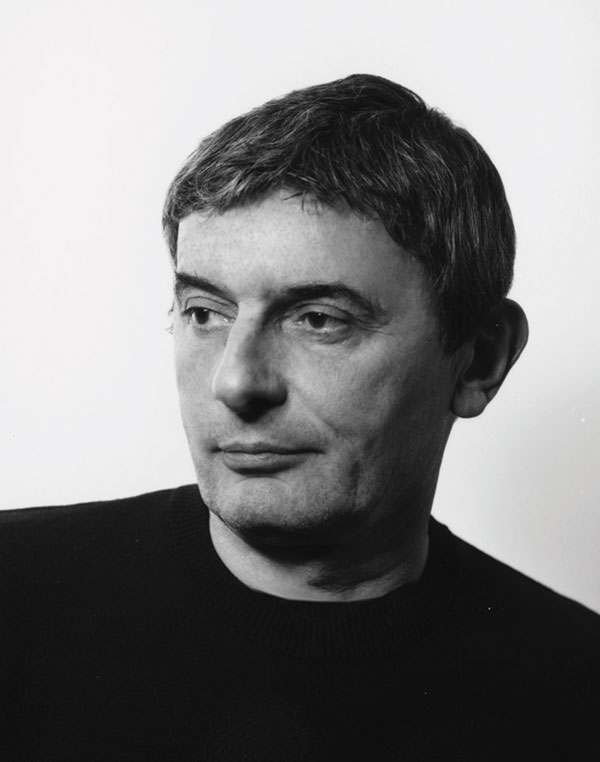 An exhibition view of a group show at Galerie Jousse Entreprise, Paris, 2012, featuring the work of Jean Prouvé. | © COURTESY JOUSSE ENTREPRISE, PARIS
An exhibition view of a group show at Galerie Jousse Entreprise, Paris, 2012, featuring the work of Jean Prouvé. | © COURTESY JOUSSE ENTREPRISE, PARIS
Design
Philippe Jousse Looks Back and Forward
PHILIPPE JOUSSE, FOUNDER of Jousse Entreprise, one of the leading design galleries in Paris, is not one to blow his own horn. While the French governing and cultural elite habitually defines itself by its schooling, Jousse claims a workaday alma mater. “I was trained at the école de Vanves” he said in a recent interview: No Grande École, Vanves, just a small weekend street market for junk and bric-a-brac in a working class neighborhood on the southern fringe of Paris.
Born in 1952 in Le Mans, a provincial city best known for its twenty-four-hour car race, Jousse arrived in Paris at sixteen to seek a living as a photographer. Ten years later he found the French modernists. “One day in 1978 I bought a table by Jean Prouvé and with it was a ten-page article by Jacques Adnet on the global work of Prouvé—his architecture, furniture and structures,” Jousse says. The monograph by Adnet, one of the leading French exponents of art deco and modernist design, had a profound impact. “I was smitten. Within a few months I became passionate about this designer. My encounter with the work of Jean Prouvé changed my life.”
This was a vibrant time in the Parisian art world. The Centre Pompidou had been inaugurated just a year earlier, in 1977. Now, work was beginning on converting the disused Gare d’Orsay into the Musée d’Orsay; meanwhile, the famed Drouot auction rooms were temporarily lodged in the grand salons of the former Orsay station hotel while their new premises were being built across the river.
Art deco was in. Jousse loved the buzz of the art market. But with no money of his own, no financial backers, and no contacts, the work of the likes of Émile-Jacques Ruhlmann was way beyond his financial reach. Still, he was determined to start somewhere; given his limited circumstances, the obvious place to start was the flea market. “I learned the trade on the job. I had no art history training so I was inclined to be more radical in my approach,” he explains.
It was in the Paris flea markets that he found the modernists—Prouvé and Charlotte Perriand, Jean Royère and Pierre Jeanneret, friends, associates and disciples of Charles Édouard Jeanneret, aka Le Corbusier. In the 1970s they were totally out of fashion, and correspondingly affordable. What Jousse liked was the globality of their vision—that it encompassed furniture, architecture, and structure, and that there was a relationship between these different domains. What he also liked was the concept of flat-pack, modular, moveable nomadism that was inherent in their ideas. “It’s the kind of furniture that is very easy to live with,” Jousse says.
He started buying Prouvé and Perriand furniture, initially just for himself. There were no collectors to sell to, but equally there were few dealers competing for stock. The same year that Jousse bought his first table, François Laffanour—now the owner of Downtown Gallery, Jousse’s next-door neighbor in the Rue de Seine but then just another flea marketer—bought his first Prouvé chair.
By the mid-1980s Jousse had built a collection large enough to support the start of what became a series of groundbreaking solo designer shows. In 1985, a year after Prouvé’s death, came the first Prouvé show, a relatively modest no-catalogue affair in Jousse’s flea market booth; in 1987 the first solo retrospective devoted to Charlotte Perriand, followed by another in 1990; in 1994 Prouvé again, a grander show with a carefully researched catalogue; in 1995 the ceramist Georges Jouve; in 2000 the furniture maker Jean Royère.
At the same time Jousse started to expand his market, opening to an international clientele through Sanford Smith’s Modernism shows in New York. “There was a novelty effect. Between 1985 and 1988 the style caught on in New York, when people like Brant bought Jean Royère and Prouvé,” Jousse says, referring to the collector Peter Brant: “People would meet at our stand and chat.”
In 1989 a young Patrick Seguin spotted a Prouvé Standard chair at Jousse’s stall—then in Marché Paul Bert, part of the St. Ouen flea market behind Montmartre—and, like Jousse himself, was instantly wowed. The two went into business together, opening a gallery in the up-and-coming Bastille district of eastern Paris, a few blocks from the newly built Bastille Opera house. For roughly a decade they worked together, widening and deepening the French modernist market through major shows and meticulously prepared monograph-catalogues—perhaps most notably their joint show of Prouvé at the 2000 Venice Architecture Biennial.
But the Venice show was something of a swansong. Around the same time, the partnership ended and the two gallerists went separate ways. Galerie Jousse-Seguin split into Galerie Patrick Seguin and Jousse Entreprise.
For Emmanuel Berard, design specialist at the French auction house Artcurial, the split reflected a widening divergence of interests. Seguin, he said, was increasingly concentrating on the architectural aspects of modernist design while Jousse was ranging wider. “The great thing about Jousse is that he does a lot of trail-blazing,” Berard said in a phone interview. “He’s full of curiosity. He was the first to look at Prouvé. He and Seguin were pioneers; but while Seguin and others, like Laffanour, have concentrated on the 1950s, Jousse has a much wider angle of vision, a wider curiosity. He’s still faithful to the furniture, he still shows Perriand, Prouvé, Jouve, but he’s also moved into ceramics and contemporary art. He was one of the first to show Pierre Paulin, to promote Roger Tallon, Mathieu Matégot, the Lalannes, designers of the 1960s, ’70s and ’80s. He’s more eclectic.”
Reflecting that eclecticism, Jousse now has two galleries—18 Rue de Seine for architect furniture and design, and 6 Rue Saint-Claude, across the river in the Marais district, for contemporary art. The art gallery presents the work of more than a dozen artists, including the American Richard Kern, the Japanese Kishin Shinoyama, and the Danish collective Superflex. “I like working with living artists, accompanying their development—and over time Prouvé and his circle have died,” Jousse says.
“One thing that’s certain is that furniture is not art,” he adds. “Function defines the form. I adore Prouvé, but I have to do other things. Art is my second passion—related but not related.”
To run the galleries (plus, inevitably in the modern market, international art fair stands and pop-up shows for global collectors) Jousse works with a team of ten. He also works with his son Matthias, who abandoned a career in theater to join the business in 2002. “I was an assistant director but from the age of twenty I was already buying a few pieces at the Paul Bert market,” Matthias Jousse told me. “Then my father proposed to me to come to the gallery and show ‘60s and ‘70s design. So I’m extending the gallery, following the same track but twenty years later. My father knew Prouvé and Paulin toward the end of their lives. Over the years, they’ve passed on. We need contemporary artists for new inspiration. We need them, to breathe.”













